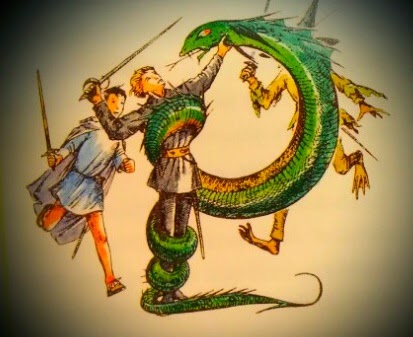Wednesday, April 9, 2014
Narnia and the 7 Deadly Sins ...
This Lenten season, I've been preaching a series of homilies on the 7 deadly sins. Last week at the close of the service in which I had just preached on lust, a young boy from our congregation came up to me with a comment. I am certain that he is still a bit too young to have understood much about the subject, but then he surprised [and delighted] me with this observation: "Pastor, if you really wanted to talk about lust, you should have talked about The Silver Chair. That story teaches all about the sin of lust!"
It reminded me instantly of the [abridged] article below [although King argues for a different dominant sin in The Silver Chair]. I found it after hearing Rich Lusk reference Dr King's work which traces the 7 deadly sins through Lewis's 7 Narnia novels. The full article can be found here. Enjoy!
Narnia and the Seven Deadly Sins
Dr. Don W. King
Department of English
Montreat College
© 1984 Don W. King
Several years ago I discovered an interesting relationship between the seven deadly sins and C. S. Lewis' Chronicles of Narnia.
The development of a list of seven especially damning sins is shadowy. However, the list that came to be most influential in the church was developed by Gregory the Great (540-605) characterized by its Latin acronym, saligia: superbia (pride), avaritia (greed), luxuria (luxury, later lust), invidia (envy), gula (gluttony), ira (anger), and acedia (sloth).
William Langland's Piers Plowman, Dante's Divine Comedia, Chaucer's "The Parson's Tale," and Spenser's Faerie Queen all devote serious attention to these. It is not surprising then that Lewis knew them so well. Throughout The Allegory of Love Lewis refers to the seven deadly sins. In several other works he refers to specific sins on the list and in Poems he focuses an entire poem, "Deadly Sins," on each one. It is my contention that he may either consciously or subconsciously have emphasized one of the seven deadly sins in each one of the seven Narnian books.
In The Lion, the Witch and the Wardrobe, Edmund personifies gluttony.
Labels:
C.S. Lewis,
charity,
church history,
ecclesiology,
holiness,
homosexuality,
orthodoxy,
quotes,
the gospel,
theology
Tuesday, April 8, 2014
Book List [what I've been reading lately] ... 4 biographies
Since It's been ages since I've posted one of these ... I did recently just finish this latest set of 4.
You are what your mind eats ...
You are what your mind eats ...
Monday, April 7, 2014
Repentance All the Way Down: PRIDE
"There is one vice of which no man in the world is free; which every one in the world loathes when he sees it in someone else; and of which hardly any people, except Christians, ever imagine that they are guilty themselves. I have heard people admit that they are bad-tempered, or that they cannot keep their heads about girls or drink, or even that they are cowards. I do not think I have ever heard anyone who was not a Christian accuse himself of this vice. And at the same time I have very seldom met anyone, who was not a Christian, who showed the slightest mercy to it in others. There is no fault which makes a man more unpopular, and no fault which we are more unconscious of in ourselves. And the more we have it in ourselves, the more we dislike it in others.
“The vice I am talking of is Pride or Self-Conceit: and the virtue opposite to it, in Christian morals, is called Humility. You may remember, when I was talking about sexual morality, I warned you that the centre of Christian morals did not lie there. Well, now, we have come to the centre. According to Christian teachers, the essential vice, the utmost evil, is Pride. Unchastity, anger, greed, drunkenness, and all that, are mere flea bites in comparison: it was through Pride that the devil became the devil: Pride leads to every other vice: it is the complete anti-God state of mind.”
- C S Lewis, Mere Christianity
[illustration: Kali Ciesemier]
Labels:
C.S. Lewis,
feminism,
homosexuality,
orthodoxy,
quotes,
the gospel,
theology
Friday, April 4, 2014
Psalter Statistics
The exact number of quotations is very difficult to determine precisely. Some strong allusions as well as narrative fulfillments may not be reflected on this chart.
Data compiled from a number of sources here, here, and here [as well as others hard copy resources].
Subscribe to:
Posts (Atom)






